Mar 26 2016
This is Alya Nouasri
“Exuberant, creative, bright-eyed, smart and beautiful in so many ways, Alya Nouasri loves to organize and work and advance the social good, like organizing a Community Food Mentor program, which is where I first met her.”— Elaine Mandrona
Last June (2015) Alya Nouasri and the Mapleton Teaching Kitchen’s Janet Hamilton facilitated the first of their two Community Food Mentor (CFM) programs. The CFM program is where participants learn about food security, safety and nutrition, plus grant writing for community food action, and group cooking. Alya was bent on feeding us the best of food and went out of her way to purchase fresh veggies and goodies from Dolma Foods (now resurrected after a January fire) and kept us supplied with vegan almond cookies—always in demand.
Love for good food is from family
Alya’s love and respect for good food come naturally to her. “My grandparents have always been into gardening. My parents have always been into gardening. So it’s always just been in the family.”
Originally from Whitby, Ontario, she says the richness of the soil there meant there was always lots of wonderful produce. “I remember when I was young buying bushels of peaches with my grandmother and canning peaches at our kitchen table and bushels of tomatoes at the end of the growing season and canning tomatoes. So the connection with the growers and the canning process has always been natural.”
When the family moved to New Brunswick, that connection was lost, but now, through her gardening, her volunteering and her workshops, she is helping reconnect people with growers and good food.
Alya is passionate about hydroponics
Alya says that she got involved in hydroponics as a kind of therapy. “I found that during the summer when I was outdoors and gardening – specifically more flower gardens than anything – I was really happy and then I would work in the winter and I would have no garden and it caused a lot of seasonal depression and so the solution was this tent.”
Since then she has become a serious hydroponics gardener, and educator and grows tomatoes, lettuce, eggplant and peppers in her 6 x 6 x 6 Mylar tent. Her dream is to create a huge hydroponics system in an old warehouse or abandoned building that potentially could help feed many Monctonians.
But growing food is just one of three prongs to her dream. The second is an educational component complete with a teaching kitchen, school tours, whatever it takes to share their knowledge with the community.
“The third prong,” Alya says, “is we’d like to be able to share our knowledge with, say, Fredericton or Saint John so that they can replicate what we’re doing here. So it’s like this huge castle but we have to work on it piece by piece.”
And then there are the chickens
And then there are the chickens. She has four chickens — the maximum allowed by law in Moncton — and to listen to the degree of detail she knows about each of their personalities, you’d think she was the parent of four adopted children. But they’re children that supply lots of fresh eggs.
A Gallery of Alya Nouasri
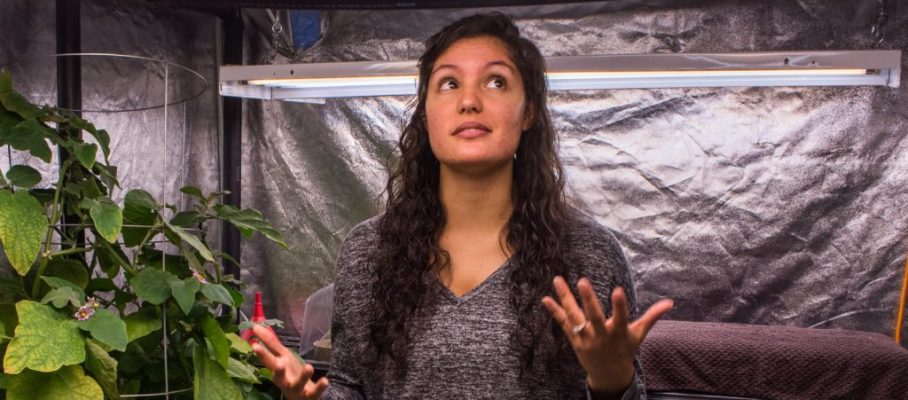
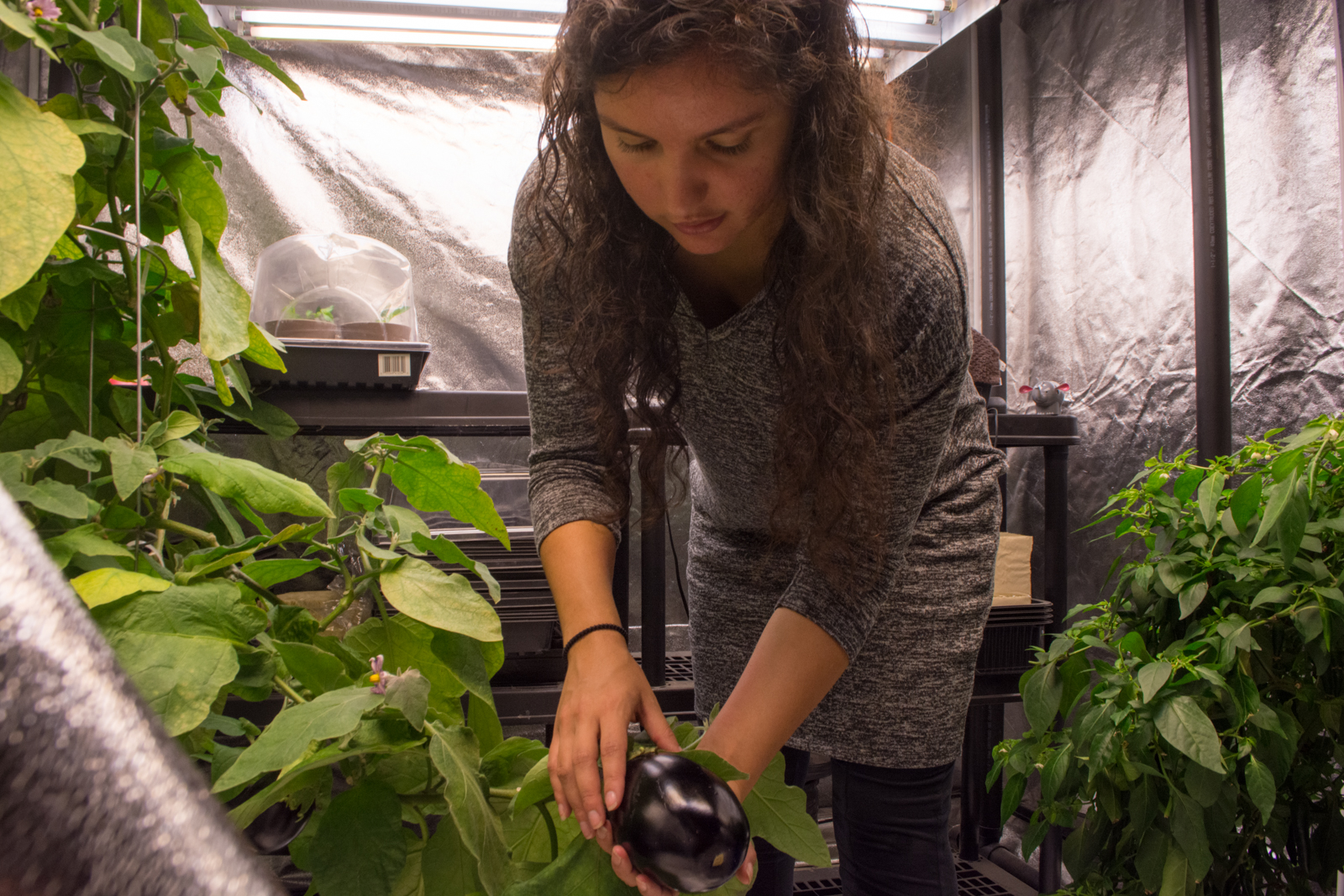
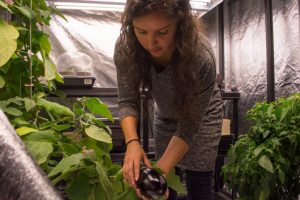
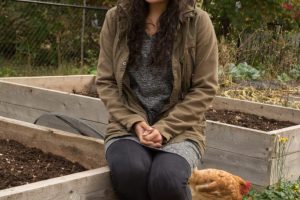
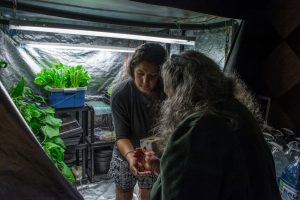
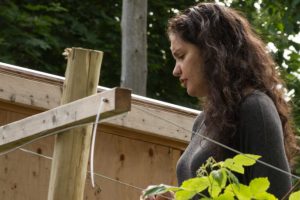
Oct 3 2017
Why Kids Should Learn to Garden and Do Art
Truth is, I’m worried about the kids. The world is changing. Major shifts are underway environmentally, politically, economically — in just about every way, really. Just like kids need to learn to tie their shoes and brush their teeth, I believe they need to learn how to grow their own food, because it’s part of taking care of themselves. If kids don’t eat well, they won’t be healthy, and if they aren’t healthy, they can’t do much of anything in this challenging world.
I have been teaching gardening for the past two years at the Boys and Girls Club of Moncton, and I have been supporting that learning with “garden art.”
In early spring, when the kids are released from the grey confinement of winter and we tear out old debris, turn the soil, and plant seeds, then energy and excitement abound. Delight is always the initial reaction. From one tiny seed comes a plant and then … food. If that’s not miraculous, I don’t know what is.
Once the initial euphoria wears off, everyone sees that it’s a lot of work. It can be an effort to get up the requisite gumption and everyone groans with the prospect of numerous tasks. We need to take care of growing plants — fertilize, water, weed and nurture.
But early in the game we find our gusto again. We commit and come to love the green, growing garden. Why? Because the more you nurture a living thing the more connected to it you become. True for plants, pets and people. They learn patience, reverence and respect for how long it takes to grow food. They learn to observe.
Looking for Beauty
Children find beauty everywhere in the garden. What is beautiful about doing art with children in the garden is that they see it as someplace to be, someplace they can spend time with growing things.
Furthermore, we look for beauty in the garden and have fun expressing that in art, and there the learning deepens, the mind is calmed and the soul is fed. Some see glowing light around the plants and draw that. Some talk to the plants and caress them like pets. They gently hold small bugs found in the soil or on leaves and watch them wiggle their antennae and give them names. We draw these bugs or create some out of found natural objects, paint and glue. Some of the kids dance and play. Gardening is a theatre where simple acts are an antidote for cynicism and a balm for the imagination.
Growing Food Makes You Generous
Growing your own food is the single most important act you can do to reclaim power politically and socially. With this basic activity you break your dependence on the corporate food system, using your labour and skills. Who knows what is going to happen to our food supply in the next few years? Who knows how it will be for the kids?
By growing your own food, you save money. It’s an economic buffer. And you know where your food comes from and what you’re getting. You become more connected to other people. I am compelled to generously and proudly share food with family and neighbours. And the kids are too. They always want to bring some home for their families.
Vegetable gardening is the single most important thing you can do for health. It works the body, the mind and gladdens the spirit. Homegrown veggies are more nutritious. Many people have never experienced, or have forgotten, the amazing flavour and intense vitality that comes from fresh vegetables and herbs. Feels like life bursting into your mouth. There is absolutely no other experience like it. In my mind, eating well is a form of self respect.
Even Raw Onions
The kids can’t wait to pick and eat the food. And they eat it all. Even raw onions. Even raw turnips and beets. I do show them how to cook too, but sometimes they can’t wait.
Cooking is just as important as growing food. I teach them to cook and they always love what we make. They also love the way the other children love what they make. The proof that the food is delicious is that it’s always gone at the end.
Growing your own food is a practical and loving way to connect with your kids. It’s an opportunity for fun, conversations, learning science, seeking beauty, and fostering expression through the visual arts or writing stories and poems. And with all of this comes a sense of collective accomplishment.
Gardening and Art Go Perfectly Together
I love doing art with them to help them experience the garden more deeply. We study leaf shapes and talk about photosynthesis and press the leaves into clay to make pendants. We observe the bees, butterflies, hummingbirds visiting the plants and talk about pollination.
The level of detail that children observe the garden is fascinating in itself. They love the leaves and the bees and the fruit and the bugs. They really love the bugs.
We watercolour paint coffee filters and make them into butterfly wings. We make windchimes for the garden out of recycled silverware, their tinkling tones reminding us to eat healthy meals. We make plant growth patterns by blowing paint with a straw on paper. We decorate small clay pots and plant seeds in them to take home so they can observe the whole sprouting process more closely.
We make garden lanterns out of paper cups and paper bags and battery-operated tea lights so they can observe plants at night in their own yards or gardens.
We make necklaces and bracelets out of seeds and beads just because it’s fun and everyone wants to adorn themselves in an earthy, sprightly way like fairies or elves.
In a Garden is Hope
Gardens are all about hope. And so are children. It’s marvellous to watch how much they love to go out each week to see how much the garden has grown.
In a garden — in our garden — there is growth, change and renewal, but mostly there is hope. And lots of it.
Recently I had an experience that opened my heart wide. A sweet small boy with huge brown eyes, dark lashes and a half moon smile still full of baby teeth, twirled and skipped as we made our way to the garden bed. He had recently arrived in Canada.
“I’m happy,” he said to me.
“That’s great! If you’re happy I’m happy. Why are you happy?”
“Because you are growing food for us.”
And he ran off to see how the peas were doing, plucked a pod and popped the whole edible “pois mange tout” into his mouth. So simple and satisfying.
Growing food is hope, making art is hope. Children are hope, growing so much in one season just like the plants. And with hope we are like the plant’s roots, always seeking what is fertile ground. And we are forever like the sunflowers, turning our faces toward the sun.
By Elaine Mandrona • art, children, food security • Tags: art, children, food, gardening, urban gardening